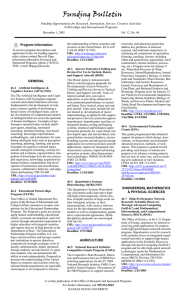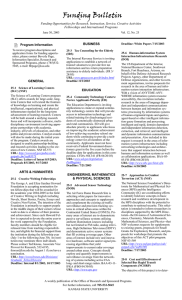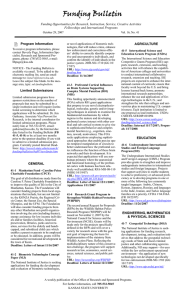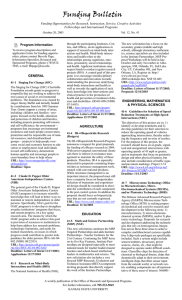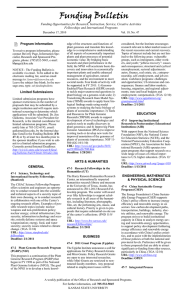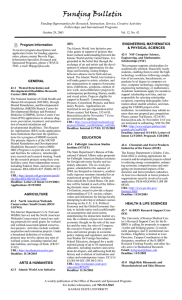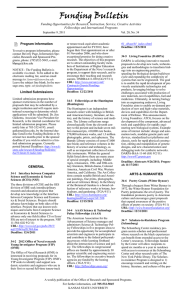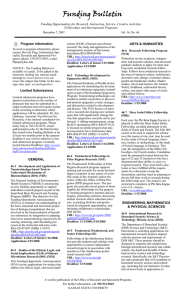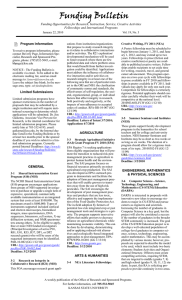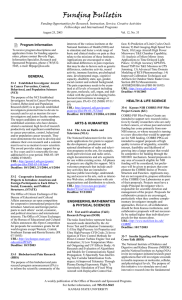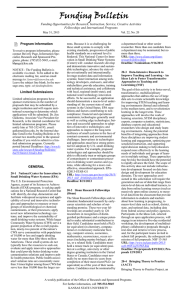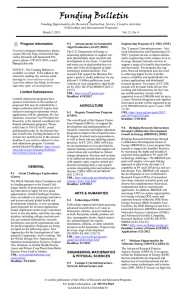Funding Bulletin
advertisement
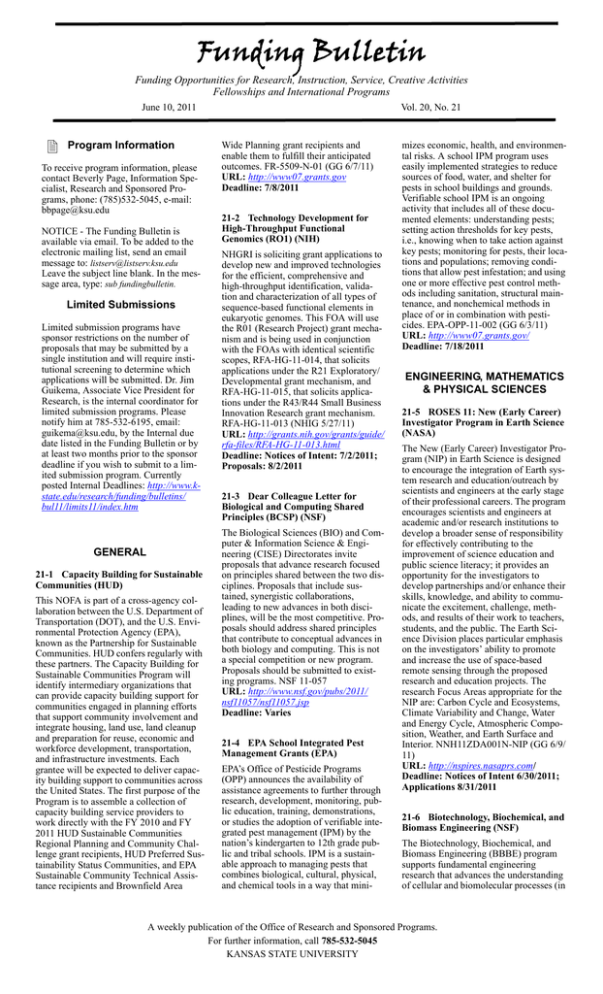
Funding Bulletin Funding Opportunities for Research, Instruction, Service, Creative Activities Fellowships and International Programs June 10, 2011 Program Information To receive program information, please contact Beverly Page, Information Specialist, Research and Sponsored Programs, phone: (785)532-5045, e-mail: bbpage@ksu.edu NOTICE - The Funding Bulletin is available via email. To be added to the electronic mailing list, send an email message to: listserv@listserv.ksu.edu Leave the subject line blank. In the message area, type: sub fundingbulletin. Limited Submissions Limited submission programs have sponsor restrictions on the number of proposals that may be submitted by a single institution and will require institutional screening to determine which applications will be submitted. Dr. Jim Guikema, Associate Vice President for Research, is the internal coordinator for limited submission programs. Please notify him at 785-532-6195, email: guikema@ksu.edu, by the Internal due date listed in the Funding Bulletin or by at least two months prior to the sponsor deadline if you wish to submit to a limited submission program. Currently posted Internal Deadlines: http://www.kstate.edu/research/funding/bulletins/ bul11/limits11/index.htm GENERAL 21-1 Capacity Building for Sustainable Communities (HUD) This NOFA is part of a cross-agency collaboration between the U.S. Department of Transportation (DOT), and the U.S. Environmental Protection Agency (EPA), known as the Partnership for Sustainable Communities. HUD confers regularly with these partners. The Capacity Building for Sustainable Communities Program will identify intermediary organizations that can provide capacity building support for communities engaged in planning efforts that support community involvement and integrate housing, land use, land cleanup and preparation for reuse, economic and workforce development, transportation, and infrastructure investments. Each grantee will be expected to deliver capacity building support to communities across the United States. The first purpose of the Program is to assemble a collection of capacity building service providers to work directly with the FY 2010 and FY 2011 HUD Sustainable Communities Regional Planning and Community Challenge grant recipients, HUD Preferred Sustainability Status Communities, and EPA Sustainable Community Technical Assistance recipients and Brownfield Area Vol. 20, No. 21 Wide Planning grant recipients and enable them to fulfill their anticipated outcomes. FR-5509-N-01 (GG 6/7/11) URL: http://www07.grants.gov Deadline: 7/8/2011 21-2 Technology Development for High-Throughput Functional Genomics (RO1) (NIH) NHGRI is soliciting grant applications to develop new and improved technologies for the efficient, comprehensive and high-throughput identification, validation and characterization of all types of sequence-based functional elements in eukaryotic genomes. This FOA will use the R01 (Research Project) grant mechanism and is being used in conjunction with the FOAs with identical scientific scopes, RFA-HG-11-014, that solicits applications under the R21 Exploratory/ Developmental grant mechanism, and RFA-HG-11-015, that solicits applications under the R43/R44 Small Business Innovation Research grant mechanism. RFA-HG-11-013 (NHIG 5/27/11) URL: http://grants.nih.gov/grants/guide/ rfa-files/RFA-HG-11-013.html Deadline: Notices of Intent: 7/2/2011; Proposals: 8/2/2011 21-3 Dear Colleague Letter for Biological and Computing Shared Principles (BCSP) (NSF) The Biological Sciences (BIO) and Computer & Information Science & Engineering (CISE) Directorates invite proposals that advance research focused on principles shared between the two disciplines. Proposals that include sustained, synergistic collaborations, leading to new advances in both disciplines, will be the most competitive. Proposals should address shared principles that contribute to conceptual advances in both biology and computing. This is not a special competition or new program. Proposals should be submitted to existing programs. NSF 11-057 URL: http://www.nsf.gov/pubs/2011/ nsf11057/nsf11057.jsp Deadline: Varies 21-4 EPA School Integrated Pest Management Grants (EPA) EPA’s Office of Pesticide Programs (OPP) announces the availability of assistance agreements to further through research, development, monitoring, public education, training, demonstrations, or studies the adoption of verifiable integrated pest management (IPM) by the nation’s kindergarten to 12th grade public and tribal schools. IPM is a sustainable approach to managing pests that combines biological, cultural, physical, and chemical tools in a way that mini- mizes economic, health, and environmental risks. A school IPM program uses easily implemented strategies to reduce sources of food, water, and shelter for pests in school buildings and grounds. Verifiable school IPM is an ongoing activity that includes all of these documented elements: understanding pests; setting action thresholds for key pests, i.e., knowing when to take action against key pests; monitoring for pests, their locations and populations; removing conditions that allow pest infestation; and using one or more effective pest control methods including sanitation, structural maintenance, and nonchemical methods in place of or in combination with pesticides. EPA-OPP-11-002 (GG 6/3/11) URL: http://www07.grants.gov/ Deadline: 7/18/2011 ENGINEERING, MATHEMATICS & PHYSICAL SCIENCES 21-5 ROSES 11: New (Early Career) Investigator Program in Earth Science (NASA) The New (Early Career) Investigator Program (NIP) in Earth Science is designed to encourage the integration of Earth system research and education/outreach by scientists and engineers at the early stage of their professional careers. The program encourages scientists and engineers at academic and/or research institutions to develop a broader sense of responsibility for effectively contributing to the improvement of science education and public science literacy; it provides an opportunity for the investigators to develop partnerships and/or enhance their skills, knowledge, and ability to communicate the excitement, challenge, methods, and results of their work to teachers, students, and the public. The Earth Science Division places particular emphasis on the investigators’ ability to promote and increase the use of space-based remote sensing through the proposed research and education projects. The research Focus Areas appropriate for the NIP are: Carbon Cycle and Ecosystems, Climate Variability and Change, Water and Energy Cycle, Atmospheric Composition, Weather, and Earth Surface and Interior. NNH11ZDA001N-NIP (GG 6/9/ 11) URL: http://nspires.nasaprs.com/ Deadline: Notices of Intent 6/30/2011; Applications 8/31/2011 21-6 Biotechnology, Biochemical, and Biomass Engineering (NSF) The Biotechnology, Biochemical, and Biomass Engineering (BBBE) program supports fundamental engineering research that advances the understanding of cellular and biomolecular processes (in A weekly publication of the Office of Research and Sponsored Programs. For further information, call 785-532-5045 KANSAS STATE UNIVERSITY vivo, in vitro, and/or ex vivo) and eventually leads to the development of enabling technology and/or applications in support of the biopharmaceutical, biotechnology, and bioenergy industries, or with applications in health or the environment. Quantitative assessments of bioprocesses are considered vital to successful research projects in the BBE program. The program encourages proposals that address emerging research areas and technologies that effectively integrate knowledge and practices from different disciplines, and effectively incorporate ongoing research into educational activities. PD-12-1491 (GG 6/8/11) URL: http://www.nsf.gov/funding/ pgm_summ.jsp?pims_id=501024 Deadline: Target Date 9/15/2011 21-7 Biosensing (NSF) The Biosensing program supports fundamental research in engineering areas related to: Novel sensitive, discriminative, low cost, and easy to operate biosensing systems; innovative ideas in the development of novel biorecognition strategies; multifunctional nanomaterials and interfaces with predefined physical, chemical, or biological characteristics for biosensing applications; fundamental study of bio-macromolecules confinement and orientation at the micro- and nano-interfaces for biosensing applications; and molecular sensors capable of monitoring biological structures interaction (protein-protein interactions, cell-tocell talk, interkingdom signaling, etc.) Proposals outside of these specific interest areas are welcome. Projects submitted to the Program must advance both engineering and life sciences. PD-12-7909 (GG 6/8/11) URL: http://www.nsf.gov/funding/ pgm_summ.jsp?pims_id=503353 Deadline: Target Date 9/15/2011 21-8 Sloan Research Fellowships (Sloan) The Sloan Research Fellowships seek to stimulate fundamental research by earlycareer scientists and scholars of outstanding promise. These fellowships are awarded to researchers in recognition of distinguished performance and a unique potential to make substantial contributions to their field. Over the first 17 years of the program, Sloan Research Fellowships were awarded in physics, chemistry, and mathematics. Additional fields were added in subsequent years; neuroscience in 1972, economics in 1980, computer science in 1993, and computational and evolutionary molecular biology in 2002. Candidates are nominated by department heads or other senior researchers. Direct applications are not accepted. More than one candidate from a department may be nominated, but no more than three. URL: http://www.sloan.org/fellowships Deadline: 9/15/2011 21-9 Earth System Science Pathfinder Program: Earth Venture-2 The National Aeronautics and Space Administration (NASA) Science Mission Directorate (SMD) is releasing a NASA Announcement of Opportunity (NNH11ZDA012O), Earth Venture-2 (EV-2). Earth Venture is an element within the Earth System Science Pathfinder (EESP) Program that conducts Principal Investigator (PI)-led Earth Science investigations relevant to SMD’s Earth Science Division. NASA expects to select one EV-2 mission to proceed into formulation and implementation. Launch Readiness Date (LRD) is to occur no later than April 30, 2017. The proposed missions must support the goals and objectives of the ESSP Program and the EV-2 element. NNH11ZDA012O URL: http://nspires.nasaprs.com/ Deadline: Notices of Intent 7/22/2011, Proposals 9/15/2011 HEALTH & LIFE SCIENCES 21-10 New York Stem Cell Foundation Invites Applications for Early Career Investigator Awards (NYSCF) The New York Stem Cell Foundation is accepting funding applications from early career investigators in the United States, Canada, and the United Kingdom for research that explores the therapeutic potential of human stem cells. The Innovator Awards for Early Career Investigators program is designed to support scientists in postdoctoral phase of their careers. The initiative’s main goal is to foster truly innovative science that is likely to transform the field of stem cell research and advance the understanding and eventual use of stem cells for the treatment of human disease. (PND 5/27/ 11) URL: http://www.nyscf.org/grants/ investigator-awards Deadline: 7/8/2011 21-11 Strategies for the Protection of Pregnant Women and Infants Against Infectious Diseases (R01) (NIH) The purpose of this FOA is to encourage new and innovative mechanistic studies of pathogens that impact placental function and fetal well-being, with the longterm goal of informing the development of interventions against these pathogens and reducing the burden of infectionrelated pregnancy loss and infant morbidity and morality. RFA-AI-11-036 (NIHG 5/27/11) URL: http://grants.nih.gov/grants/guide/ rfa-files/RFA-AI-11-036.html Deadline: Letters of Intent 9/13/2011; Applications 10/13/2011 tissues. This initiative seeks to stimulate basic and early-stage translational research focused on development of novel therapeutic strategies that address intoxication or infection of the brain and/or neurons by select biodefense toxins and pathogens. Responsive applications will define and address a therapeutic need specific to a targeted neurotropic toxin or pathogen; applications that focus on development of novel or adjunctive technologies to facilitate transport of new or existing therapeutics across the bloodbrain barrier or into affected neurons are of particular interest. RFA-AI-11-027 (NIHG 5/27/11) URL: http://grants.nih.gov/grants/guide/ rfa-files/RFA-AI-11-027.html Deadline: Letters of Intent 9/23/2011, Applications 10/24/2011 SOCIAL SCIENCES 21-13 Establish a Poverty Research Center Program (HHS) ASPE plans to fund up to three (3) Poverty Research Centers. The Poverty Research Center grants are for qualified institutions to provide a focused national and regional and/or state agenda expanding our understanding of the causes, consequences, and effects of inequality and poverty and policies and programs to remediate and alleviate poverty, inequality and their affects. It is anticipated that investigators supported under the Poverty Research Center will benefit from their opportunity to conduct independent research; that the grantee institution will benefit from participation in the diverse extramural programs of HHS and other federal agencies; and that students will benefit from exposure to and participation in research and will be encouraged to pursue graduate studies and careers in the social and behavioral sciences with a focus on poverty and inequality. HS-11023 (GG 6/3/11) URL: http://www07.grants.gov/ Deadline: 7/20/2011 R.W. Trewyn, Vice President for Research Jim Guikema, Associate Vice President for Research Caron Boyce, Administrative Specialist Preaward Section Paul Lowe, Director Anita Fahrny, Assistant Director Kathy Tilley, Rich Doan, Carmen Garcia, Adassa Roe, Katie Small, Rex Goff, Susan Klein, Sharon Zoeller Funding Information Specialist & Editor Beverly Page Development Director Mary Lou Marino 21-12 Therapeutics for Neurotropic Biodefense Toxins and Pathogens (R21/ R33) (NIH) The objective of this Funding Opportunity Announcement (FOA) is to support research focused on development of therapeutic strategies that target select biodefense toxins or pathogens in neural Human Subjects, Animal Care & Use, and Biosafety Gerald P. Jaax, Associate Vice President, Research Compliance Heath Ritter, Compliance Monitor Adrian Self, Administrative Specialist Congressional Relations Sue Peterson, R.W. Trewyn A weekly publication of the Office of Research and Sponsored Programs. For further information, call 785-532-5045 KANSAS STATE UNIVERSITY
